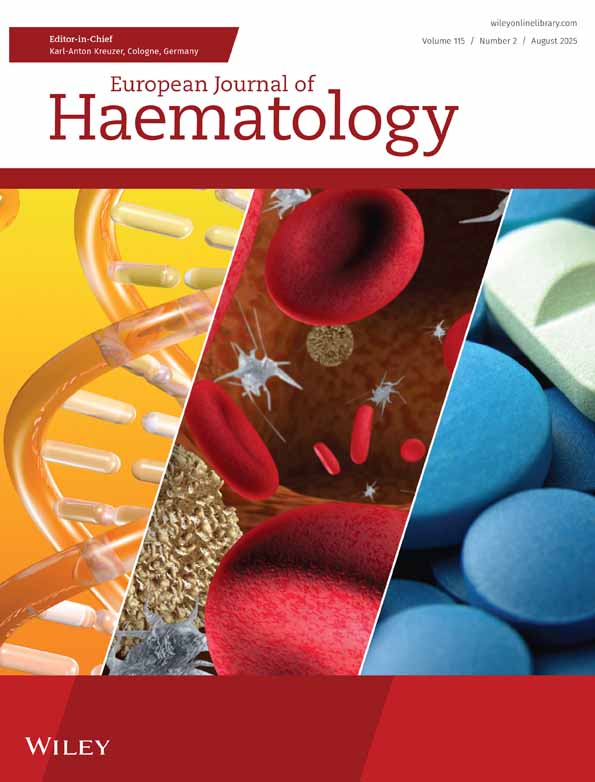Single-agent thalidomide induces response in T-cell lymphoma
G. Damaj
Institut Paoli Calmettes Cancer Center, Marseille, France
Search for more papers by this authorR. Bouabdallah
Institut Paoli Calmettes Cancer Center, Marseille, France
Search for more papers by this authorN. Vey
Institut Paoli Calmettes Cancer Center, Marseille, France
Search for more papers by this authorK. Bilger
Institut Paoli Calmettes Cancer Center, Marseille, France
Search for more papers by this authorM. Mohty
Institut Paoli Calmettes Cancer Center, Marseille, France
Search for more papers by this authorJ. A. Gastaut
Institut Paoli Calmettes Cancer Center, Marseille, France
Search for more papers by this authorG. Damaj
Institut Paoli Calmettes Cancer Center, Marseille, France
Search for more papers by this authorR. Bouabdallah
Institut Paoli Calmettes Cancer Center, Marseille, France
Search for more papers by this authorN. Vey
Institut Paoli Calmettes Cancer Center, Marseille, France
Search for more papers by this authorK. Bilger
Institut Paoli Calmettes Cancer Center, Marseille, France
Search for more papers by this authorM. Mohty
Institut Paoli Calmettes Cancer Center, Marseille, France
Search for more papers by this authorJ. A. Gastaut
Institut Paoli Calmettes Cancer Center, Marseille, France
Search for more papers by this authorAbstract
Abstract: T-cell lymphoma is an aggressive lymphoma that cannot be cured despite aggressive therapy, including autologous stem cell transplantation. Thalidomide is an immunomodulatory drug with numerous properties that has proven effective in relapsed multiple myeloma and, to a lesser extent, in other hematologic diseases. We report three cases of relapsed refractory T-cell lymphoma treated with thalidomide with a good tumor response.
References
- 1 Gisselbrecht C, Gaulard P, Lepage E et al. Prognostic significance of T-cell phenotype in aggressive non-Hodgkin's lymphomas. Groupe d'Etudes des Lymphomes de l'Adulte (GELA). Blood 1998; 92: 76–82.
- 2 Singhal S, Mehta J, Desikan R et al. Antitumor activity of thalidomide in refractory multiple myeloma. N Engl J Med 1999; 341: 1565–1571.
- 3 Raza A, Meyer P, Dutt D et al. Thalidomide produces transfusion independence in long-standing refractory anemias of patients with myelodysplastic syndromes. Blood 2001; 98: 958–965.
- 4 Tefferi A. Treatment approaches in myelofibrosis with myeloid metaplasia: the old and the new. Semin Hematol 2003; 40(Suppl. 1): 18–21.
- 5 Giovanni B, Michelle E, Letizia C et al. Thalidomide in myelofibrosis with myeloid metaplasia: a pooled-analysis of individual patient data from five studies. Leuk Lymphoma 2002; 43: 2301–2307.
- 6 Steins MB, Padro T, Bieker R et al. Efficacy and safety of thalidomide in patients with acute myeloid leukemia. Blood 2002; 99: 834–839.
- 7 Dimopoulos Ma, Zomas A, Viniou NA et al. Treatment of Waldenstrom's macroglobulinemia with thalidomide. J Clin Oncol 2001; 19: 3596–3601.
- 8 Damaj G, Lefrere F, Delarue R et al. Thalidomide therapy induces response in relapsed mantle cell lymphoma. Leukemia 2003; 17: 1914–1915.
- 9 Wilson EA, Jobanputra S, Jackson R et al. Response to thalidomide in chemotherapy-resistant mantle cell lymphoma: a case report. Br J Haematol 2002; 119: 128–130.
- 10 Kaufmann H, Raderer M, Wöhrer S et al. anti-tumor activity of rituximab plus thalidomide in patients with relapsed/refractory mantle cell lymphoma. Blood 2004; 104: 2269–2271.
- 11 Yakoub-Agha I, Moreau P, Leyfraz S et al. Thalidomide in patients with advanced multiple myeloma. Hematol J 2000; 1: 186–189.
- 12 Juliusson G, Celsing F, Turesson I et al. Frequent good partial remissions from thalidomide including best response even in patients with advanced refractory and relapsed myeloma. Br J Haematol 2000; 109: 89–96.
- 13 Waage A, Gimsing P, Juliusson G et al. Early response predicts thalidomide efficiency in patients with multiple myeloma. Br J Haematol 2004; 125: 149–155.
- 14 Raje N, Anderson K. Thalidomide – a revival story. N Engl J Med 1999; 341: 1606–1609.
- 15 D'Amato RJ, Loughnan MS, Flynn E et al. Thalidomide is an inhibitor of angiogenesis. Proc Natl Acad Sci USA 1994; 91: 4082–4085.
- 16 Rosinol L, Cibiera MT, Segarra M et al. Response to thalidomide in multiple myeloma: impact of angiogenic factors. Cytokine 2004; 26: 145–148.
- 17 Davies FE, Raje N, Hideshima T et al. Thalidomide and immunomodulatory derivatives augment natural killer cell cytotoxicity in multiple myeloma. Blood 2001; 98: 210–216.
- 18 Mohty M, Stoppa AM, Blaise D et al. Differential regulation of dendritic cell function by the immunomodulatory drug thalidomide. J Leukoc Biol 2002; 72: 939–945.
- 19 Settles B, Stevenson A, Wilson K et al. Down-regulation of cell adhesion molecules LFA-1 and ICAM-1 after in vivo treatment with the anti-TNF-alpha thalidomide. Cell mol Biol 2001; 47: 1105–1114.
- 20 Haslett PA, Klausner JD, Makonkawkeyoon S et al. Thalidomide stimulates T cell responses and interleukin 12 production in HIV-infected patients. AIDS Res Hum Retroviruses 1999; 15: 1169–1179.
- 21 Corral LG, Haslett PA, Muller GW et al. Differential cytokine modulation and T cell activation by two distinct classes of thalidomide analogues that are potent inhibitors of TNF-alpha. J Immunol 1999; 163: 380–386.
- 22 Keifer JA, Guttridge DC, Ashburner BP et al. Inhibition of NF-kappa B activity by thalidomide through suppression of IkappaB kinase activity. J Biol Chem 2001; 276: 22382–22387.
- 23 Leleu X, Magro L, Fawaz A et al. Efficacy of low dose of thalidomide in advanced multiple myeloma. Blood 2002; 100: 1519.
- 24 Palumbo A, Giaccone L, Bertola A et al. Low-dose thalidomide plus dexamethasone is an effective salvage therapy for advanced myeloma. Hematologica 2001; 86: 399–403.




